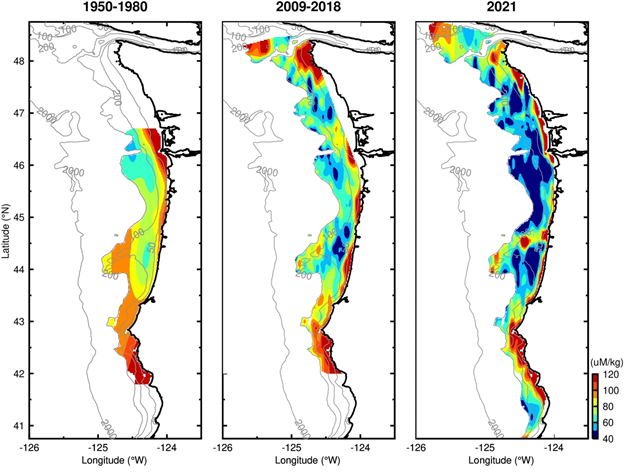
Massive die-offs of Dungeness crab have been documented off the Pacific Northwest Coast. Once dead, the crabs often wash up on beaches, such as these crabs photographed on Kalaloch Beach in Washington on June 14, 2022. Photo: Jenny Waddell, NOAA.
A NOAA-funded study demonstrated that the area of bottom water with low oxygen (hypoxia) off the Pacific Northwest coast has increased from 2% in 1950–1980 to 24% in 2009–2018. In 2021 alone, winds favoring upwelling were so strong and sustained that the resulting hypoxia covered 56% or over half of the region’s continental shelf.
Upwelling pulls nutrient-rich deep water into shallower areas. Nutrients from the upwelled water promote phytoplankton growth, which indirectly contributes to hypoxia. When large blooms of phytoplankton die and sink they stimulate microbial degradation (of the dead algae) that depletes bottom waters of oxygen. Making matters worse, upwelled water is already low in oxygen, but, in recent decades, upwelled water in the region has not had enough oxygen to remain above the hypoxic threshold of 1.4 ml/L.
Projected changes in climate are expected to keep driving this increase in hypoxia, creating more bottom and near-bottom areas in the region without enough oxygen to support most aquatic life. The goal of the study is to prepare tribal, commercial, and recreational fisheries for the future with science-based recommendations on how to bolster the readiness of the multi-million dollar Dungeness crab fishery, which has experienced mass mortality of crabs in recent years.
The mechanism responsible for hypoxia depends on location. For example, south of the Columbia River, hypoxia is attributed to large phytoplankton blooms fueled by the freshwater river plume that mixes with high-nutrient ocean water, drawing bloom-supporting nutrients up to shallower areas. Hypoxia off Heceta Bank is due to an increase in upwelling favorable winds, which bring nutrient-rich deep waters up and onto the continental shelf.
The study is the result of two projects led by Oregon State University, a multi-stressor project funded by NOAA’s NCCOS, Climate Program Office, Ocean Acidification Program, and the U.S. Integrated Ocean Observing System, in collaboration with the Office of National Marine Sanctuaries; and a Coastal Hypoxia Research Program project funded by NCCOS.

Maps of near-bottom dissolved oxygen over time. Data from 1950 to 1980 are from the World Ocean Database, data from 2009–2018 are from the NOAA Groundfish survey, and data from 2021 are from this study. Note: red areas = high oxygen, blue areas = low oxygen. Maps created with the Gri scientific graph language (Version 2.12.23, https://gri.sourceforge.net/index.php). Credit: Barth et al, 2024.
 Official websites use .gov
A .gov website belongs to an official government organization in the United States.
Official websites use .gov
A .gov website belongs to an official government organization in the United States. Secure .gov websites use HTTPS
A lock or https:// means you’ve safely connected to the .gov website. Share sensitive information only on official, secure websites.
Secure .gov websites use HTTPS
A lock or https:// means you’ve safely connected to the .gov website. Share sensitive information only on official, secure websites.